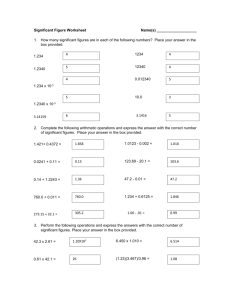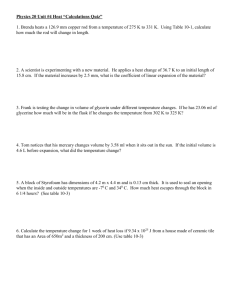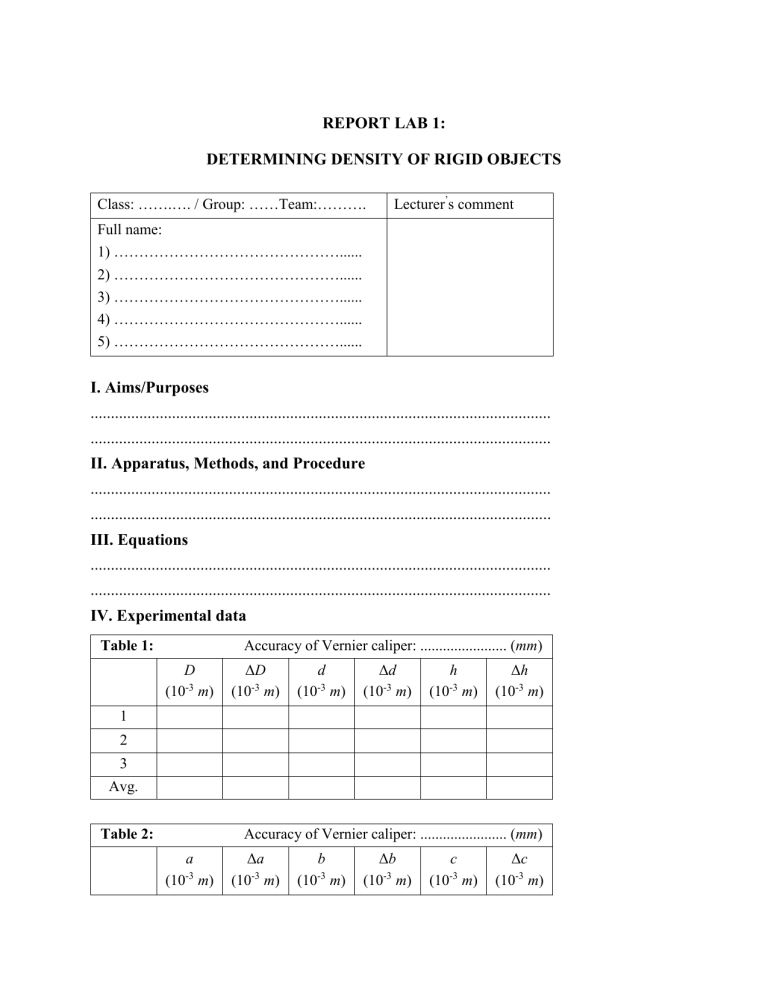
REPORT LAB 1: DETERMINING DENSITY OF RIGID OBJECTS Class: …….…. / Group: ……Team:………. Lecturer’s comment Full name: 1) ………………………………………...... 2) ………………………………………...... 3) ………………………………………...... 4) ………………………………………...... 5) ………………………………………...... I. Aims/Purposes ................................................................................................................. ................................................................................................................. II. Apparatus, Methods, and Procedure ................................................................................................................. ................................................................................................................. III. Equations ................................................................................................................. ................................................................................................................. IV. Experimental data Table 1: Accuracy of Vernier caliper: ....................... (mm) D (10-3 m) ΔD (10-3 m) d -3 (10 m) Δd (10-3 m) h -3 (10 m) Δh (10-3 m) 1 2 3 Avg. Table 2: Accuracy of Vernier caliper: ....................... (mm) a -3 (10 m) Δa (10-3 m) b -3 (10 m) Δb (10-3 m) c -3 (10 m) Δc (10-3 m) 1 2 3 Avg. Table 3: Accuracy of Vernier caliper: ....................... (mm) 1 2 3 Average =............... (10-3 m) (10-3 m) =.............. (10-3 m) -3 (10 m) Table 4: The mass of the ring, the cube, and the ball Accuracy of technical balance: …………………..(g) m1 m1 m2 m2 m3 m3 (103 kg ) (103 kg ) (103 kg ) (103 kg ) (103 kg ) (103 kg ) 1 2 3 Avg . V. Calculations V.1 Calculating the absolute errors of the measurement of dimensions ∆𝑥 = ∆𝑥𝑖𝑛𝑠𝑡𝑟𝑢𝑚𝑒𝑛𝑡 + ∆𝑥 (𝑚) V.2 Calculating the total absolute errors of the measurement of mass m ∆𝑚 = ∆𝑚𝑠𝑦𝑠 + ∆𝑚 (𝑘𝑔) V.3 Calculating the density of rigid objects (𝜋 = 3.14 and ∆𝜋 = 0.005) 𝑉1 = 𝜋 2 1 (𝐷 − 𝑑 2 )ℎ (𝑚3 ), 𝑉2 = 𝑎 × 𝑏 × 𝑐 (𝑚3 ), 𝑉3 = 𝜋𝑑 3 (𝑚3 ) 4 6 and ∆𝑉1 𝑉 = 1 ∆𝜋 + 2(𝐷. ∆𝐷 + 𝑑. ∆𝑑) 2 + ∆ℎ ℎ 𝐷2 − 𝑑 ∆𝑉2 ∆𝑎 ∆𝑏 ∆𝑐 = + + =𝛿 𝑉 𝑎 𝑏 𝑐 𝜋 =𝛿 2 ∆𝑉3 𝑉 = 3 ∆𝜋 𝜋 + 3∆𝐷 𝐷 => ∆𝑉 = 𝛿. 𝑉 = ⋯ … … (𝑚3 ) Thus, 𝜌= 𝑚 𝑉 = ⋯……( 𝑘𝑔 𝑚3 ) ∆𝜌 ∆𝑚 ∆𝑉 = + =𝛾 𝜌 𝑚 𝑉 => ∆𝜌 = 𝜌. 𝛾 = ⋯ … … ( 𝑘𝑔 𝑚3 ) VI. Conclusion 𝜌 = (𝜌 ± ∆𝜌) = ⋯ … … … … … ( 𝑘𝑔 ) 𝑚3
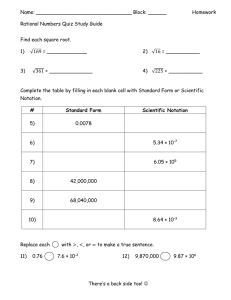


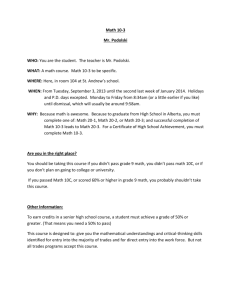
![ [m ] 2 r](http://s2.studylib.net/store/data/015969792_1-05dfe71715e1bde5a57263484b08325a-300x300.png)
